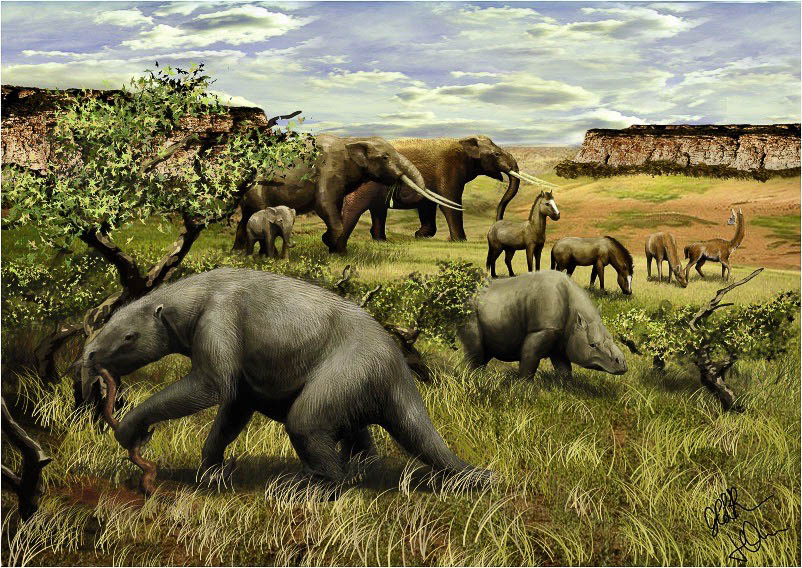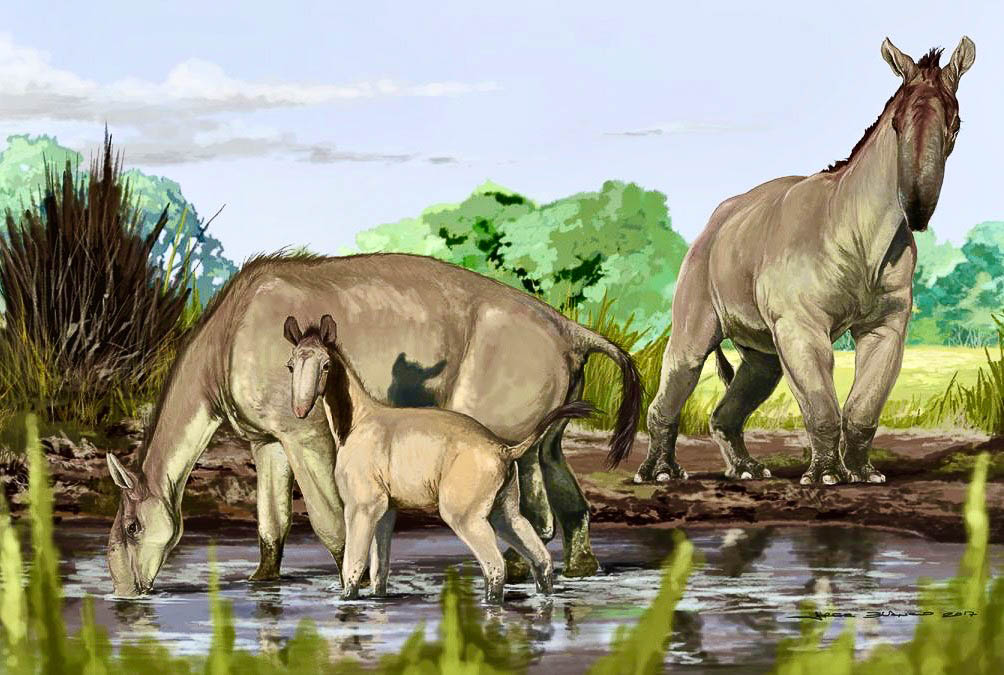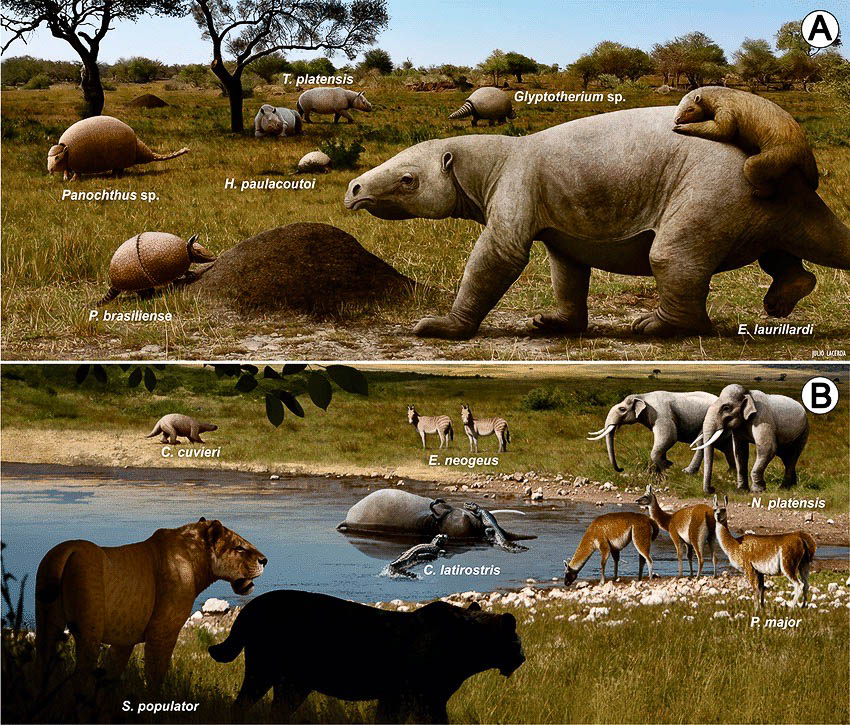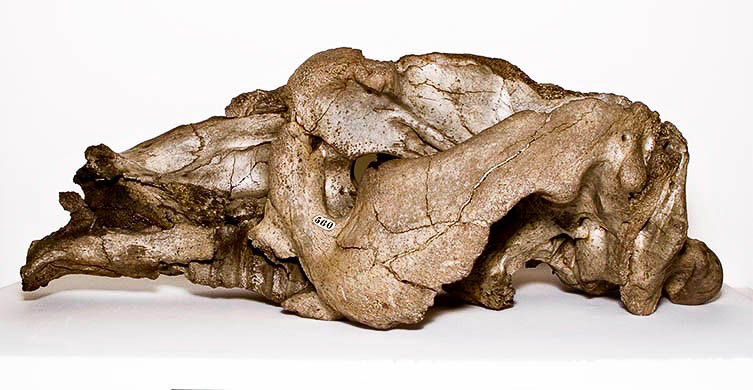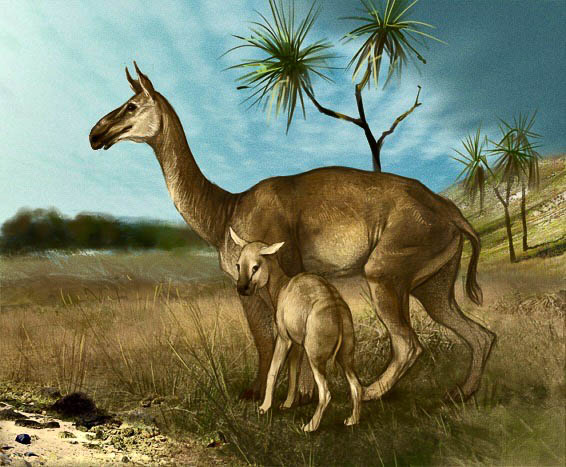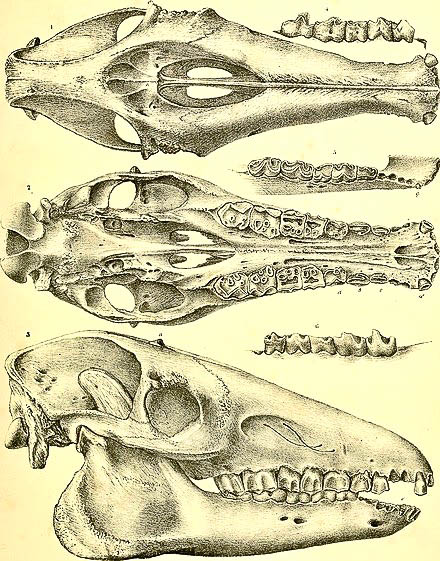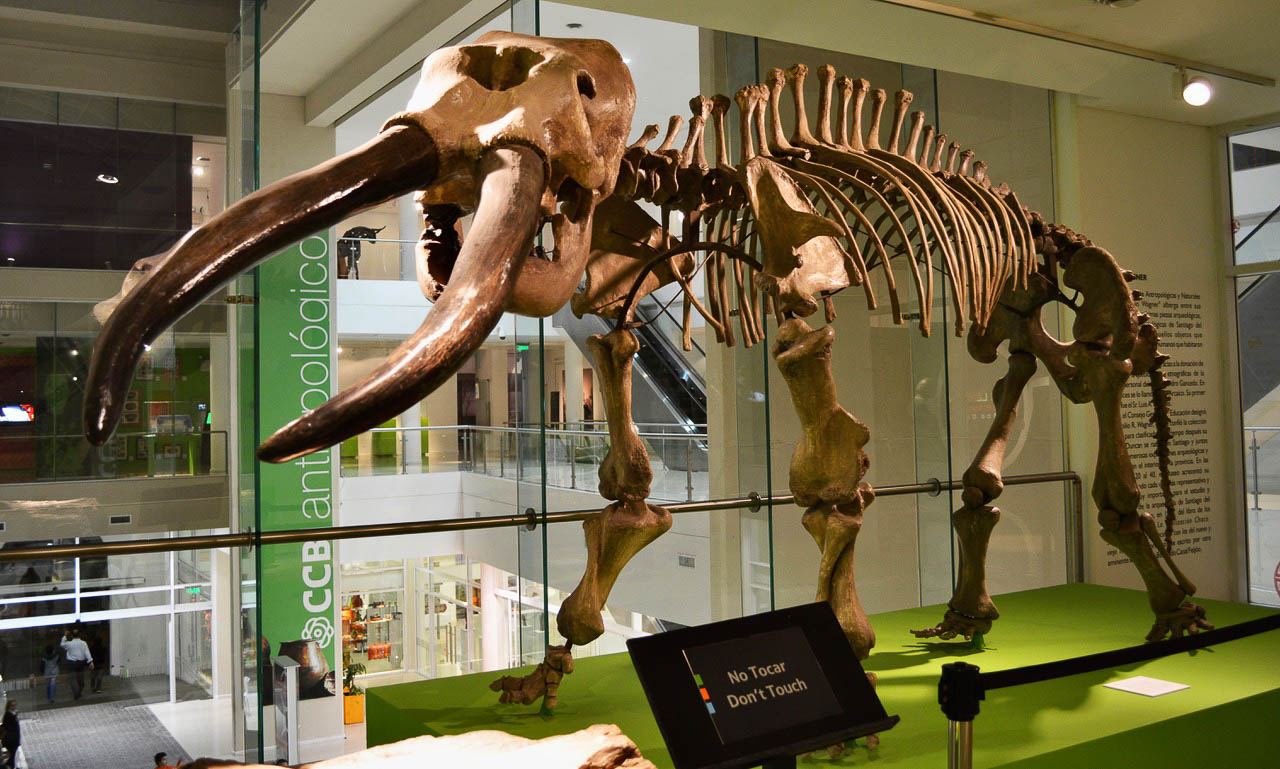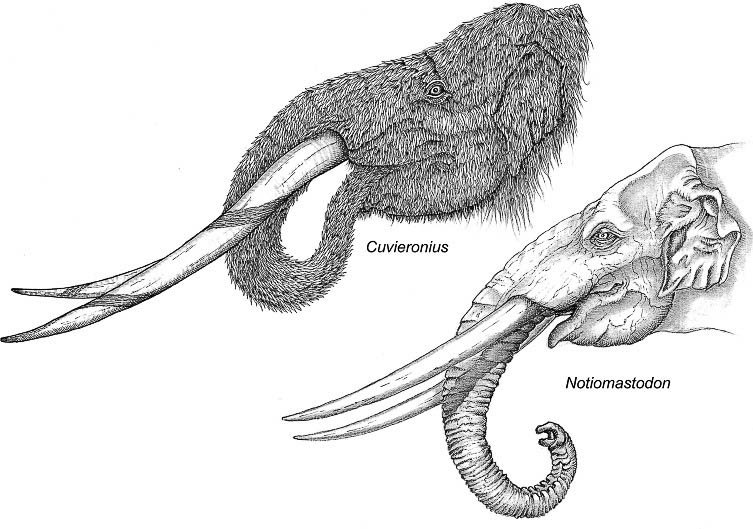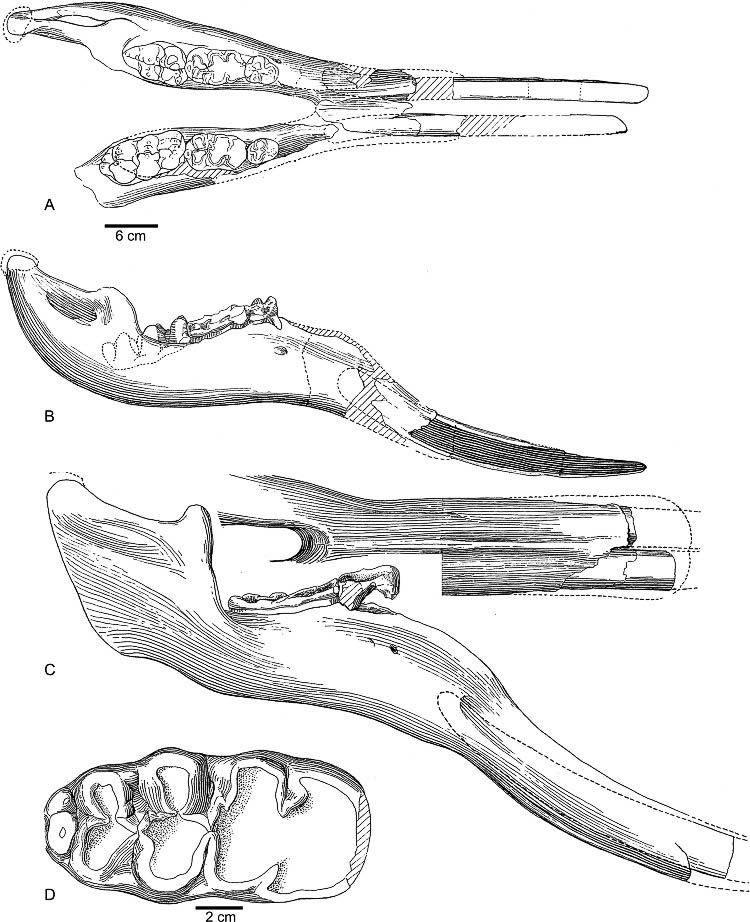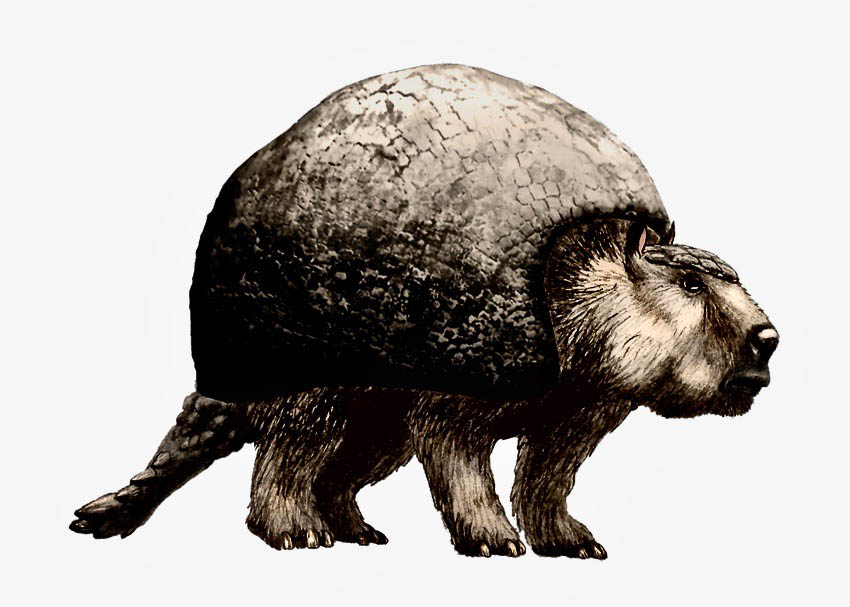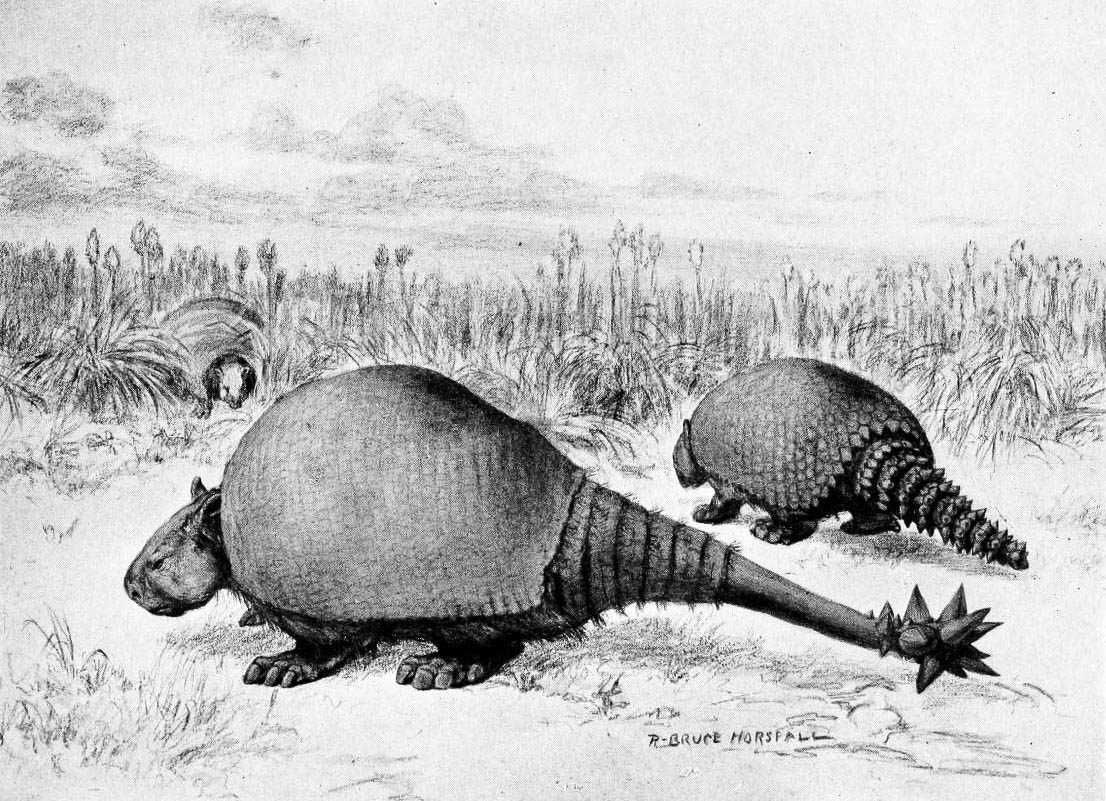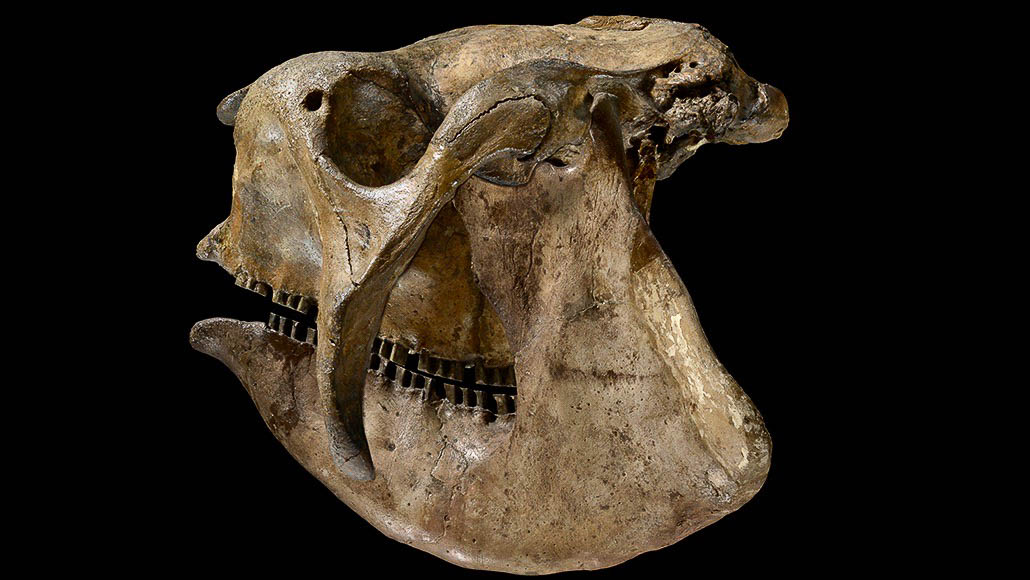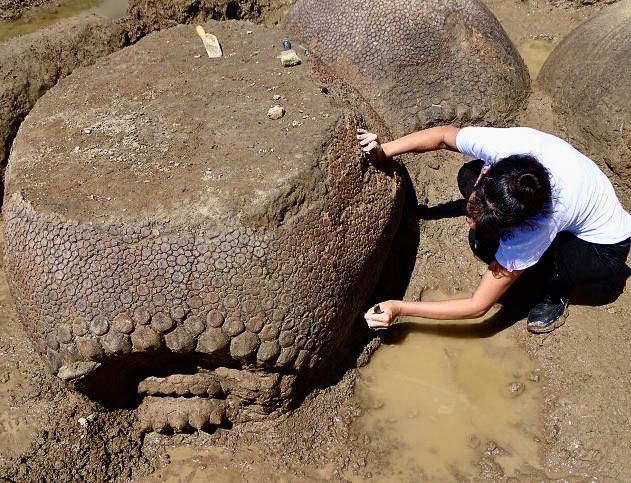ePostcard #150: Darwin’s Megafauna
‘It is impossible to reflect without the deepest astonishment, on the changed state of this continent. Formerly it must have swarmed with great monsters, like the southern parts of Africa, but now we find only the tapir, guanaco, armadillo, and capybara; mere pigmies compared to the antecedent races …. What then has exterminated so many living creatures?’
Charles Darwin writing in his Journal of Researches (1839)
Illustration Credit: Courtesy of ScienceDirect and sourced from Quaternary Science Review (https://doi.org/10.1016/j.quascirev.2019.105864)
DARWIN’S MEGAFAUNA
Charles Darwin’s discovery of several species of extinct giant mammals, the now celebrated South American megafauna of the last Ice Age, played a key role in the development of his most important contribution to science— his theory of evolution by natural selection. Having made these crucial fossil discoveries in the first couple years of the Beagle expedition, it is not surprising that he felt compelled to find even more spectacular examples as the voyage continued. Even as the Beagle headed north along the Pacific coast of South America, and Darwin was exploring older rocks with massive beds of marine fossils, his mind was still focused on finding more extinct giant mammal fossils. He wrote excitedly to John Henslow, his professor and mentor at Cambridge: ‘I have just got scent of some fossil bones of a Mammoth, what they may be, I do not know, but if gold or galloping will get them, they shall be mine.’ Darwin was clearly aware that he was making discoveries that would shake up the scientific establishment.
Illustration Credit: This painting of Macrauchenia patachonica is courtesy of artist Jorge Blanco/American Museum of Natural History. Darwin discovered the first Macrauchenia and Toxodon fossils in 1834 during his travels to South America. He found Macrauchenia on the southern coast of Argentina.
THE NEW FUSION: PALEONTOLOGY & PALEOBIOLOGY TOOLKIT
Paleontologists and evolutionary biologists continue their efforts to unravel the phylogenetic lineages and paleoecology of the extinct South American megafauna that so intrigued Darwin. Since the early 1800s, the primary paleontological lines of evidence for identifying and classifying extinct vertebrate animals, has been their anatomy, especially the bones and teeth. The South American megafaunal fossils posed a special identification challenge for Darwin and the paleontologists of that era because it was not at all obvious who the closest relatives of these extinct mammals were. Nor were there massive skeletal collections to use for comparison as there are today. The causes of the global megafaunal extinctions at the close of the last Ice Age would remain a vexing conundrum for Darwin for the remainder of his life.
Everything about the world we live in today—its geography, climate, fauna, flora, and even ourselves—has shaped and reshaped multiple times during the last 2.6 million years. The subject of this ePostcard, the Quaternary world of “Darwin’s Megafauna,“ and what we now know about those “hugest, and fiercest, and strangest” members of that Quaternary bestiary has benefitted from the interdisciplinary merging of the fields of geology and biology in exploring the evolution of life on Earth over the past 4.6 billion years.
Geology and its subdisciplines (e.g. paleontology, geochronology, geochemistry, volcanology, glaciology, and stratigraphy) and those of biology (e.g. genetics, genomics, molecular phylogeny, biochemistry, population dynamics, and paleoecology) are providing an amazing multidisciplinary platform for ongoing research. Before I introduce you to the megafaunal cast of characters, let’s review the latest advances in the research “toolkit” that scientists are now using to tell their stories.
RADIOCARBON DATING
Carbon-14 is a radioactive isotope of carbon that can be used (within limits) to establish the probable age (in calibrated calendar years) of anything containing measurable quantities of it. Radiocarbon dating is one of the most important tools in the geochronology toolkit for acquiring information about the age of things in the Quaternary Period (Pleistocene and Holocene epochs). It has recently been used to obtain a direct measurement for the age of megafaunal specimens with preserved collagen (the structural protein found in bones, skin and other connective tissues). The benefit of ancient proteins like collagen is that they contain genetic information and break down slowly.
The advent of accelerator mass spectrometry (AMS) in the late 1970s has enabled increasingly precise and accurate dates to be obtained from smaller sample sizes. Targeting specific amino acids for radiocarbon dating promises to generate even more reliable chronologies for megafaunal extinctions. Radiocarbon dating of hydroxyproline, an amino acid that rarely occurs outside of bone collagen and is resistant to degradation, has been established as a gold standard for chronological accuracy. Although AMS radiocarbon dating methods remain the most precise in the context of the last 50,000 years, developments in radiogenic and optically stimulated luminescence (OSL) dating methods have also improved megafaunal chronologies in contexts without organic preservation or extending beyond the limits of Carbon-14.
OPTICALLY STIMULATED LUMINESCENCE
Optically Stimulated Luminescence (abbreviated as OSL) can be used to date the last time individual mineral grains of quartz and feldspar were exposed to sunlight—that is, before they were last buried in sediment. From earlier ePostcards, you will remember that quartz and feldspar are the two most abundant minerals on the Earth’s surface. Unlike radiocarbon dating, this OSL does not depend on the decay of a radioactive isotope, and dates the actual sediments in which the fossils were deposited. To measure the elapsed time since burial, OSL relies on counting electrons trapped in crystal lattices since the mineral grains were last on the surface. Electron entrapment occurs at a steady rate over time, per locality, which is why OSL can be used as a chronometer. When the sample to be dated is super heated in the lab, the electrons are released in a burst of light. The results do not require calibration (unlike radiocarbon dating) and are reported in in calendar years. The useful range of OSL dating is on the order of 1 million years.
MOLECULAR BIOLOGY
Molecular biology is the branch of biology that deals with the structure and function of the macromolecules (e.g. proteins and nucleic acids) essential to life. Advances in gene sequencing technology that rely predominantly on short DNA fragments have been a boon for the ancient DNA field, greatly facilitating the assembly of whole mitochondrial genomes in particular. Shotgun Illumina sequencing has been successfully applied to a diversity of Pleistocene subfossils (part of a dead organism that is partially, rather than fully, fossilized) containing enough endogenous DNA to reconstruct complete mitogenomes.
Recent advances in ancient DNA (aDNA) analysis and the suite of scientific methods now available continues to expand and be refined, helping researchers answer questions related to megafaunal species identifications, extinction chronologies, dietary preferences, ecological relationships, environmental pressures, and the potential causes of megafaunal extinctions. Without having to rely on genetic information obtained from “close” living relatives of ancient, extinct creatures, researchers are increasingly able to reveal the evolution and phylogenic relationships of some of the most fascinating mammals in the history of life on Earth.
STABLE ISOTOPE ANALYSIS
Stable isotope analysis of carbon, nitrogen, oxygen, and strontium in animal tissues has long been applied in ecology and archeology to investigate environmental preferences, ecological niche partitioning, and dietary change. This type of analysis has recently been used to study the fine-grained details of megafaunal paleoecology. Stable carbon (δ13C), oxygen (δ18O), and nitrogen (δ15N) isotopes can now be used to derive significant physiological and ecological insights from analysis of even a single taxon (a taxonomic group of any rank, such as a species, family, or class). In some cases, stable isotope analysis of megafaunal remains has enabled the reconstruction of Pleistocene food webs and ecological competition dynamics. Stable isotope measurements of animal tissues can also be used to study climatic and environmental change experienced by different megafaunal species through time.
Illustration Credit: Courtesy of artist Julio Lacerda, 2020. (A) Pleistocene meso-megamammals from Sergipe, Brazil; B, two Smilodon populator stalking a Palaeolama major group, while two Caiman latirostris are scavenging a Notiomastodon platensis corpse.
INTRODUCING A REMARKABLE CAST OF CHARACTERS
Our modern understanding of plate tectonics, continental movements, the timing of the emergence of land bridges (e.g. the Bering Land Bridge and the Isthmus of Panama), and the Great American Biotic Interchange (the two-directional faunal movements between the Americas), provides paleontologists with a basic geologic framework for deciphering the paleogeography of the past, but many mysteries remain. After the late Mesozoic breakup of the supercontinent Gondwana, South America spent most of the Cenozoic as an island continent whose “splendid isolation,” in the words of paleontologist George Gaylord Simpson, allowed its fauna to evolve into many forms found nowhere else on Earth, most of which are now extinct.
The Great American Biotic Interchange (commonly abbreviated as GABI) is the late Cenozoic paleozoogeographic biotic interchange event in which land and freshwater fauna migrated from North America via Central America to South America and vice versa, as the volcanic Isthmus of Panama rose from the sea floor and bridged the formerly separated continents. The last and most conspicuous wave of the GABI, starting around 2.7 Ma ago.
This wave included the immigration into South America of North American ungulates (including camelids, tapirs, deer and horses), proboscids (gomphotheres), carnivorans (including felids such as cougars, jaguars and saber-toothed cats, canids, mustelids, procyonids and bears) and a number of types of rodents. The larger members of the reverse migration, besides ground sloths and terror birds, were glyptodonts, pampatheres, capybaras, and the notoungulate Mixotoxodon (the only South American ungulate known to have invaded Central America).
The late Quaternary megafaunal extinctions at the end of the Pleistocene, which resulted in the loss of up to 90% of large-bodied animal species on ice-free continents (excluding Africa), represented the most profound faunal transition that Earth’s ecosystems experienced during the Cenozoic.
TOXODON
Photo Credits: Courtesy of London’s Natural History Museum. (1, top) The artist’s rendering of Toxodon is courtesy of Mauricio Antón. This extinct giant mammal, discovered by Charles Darwin in Uruguay in 1834, is thought to have looked something like a fur-covered rhinoceros, with the head of a hippopotamus. (2, below) This skull of Toxodon was purchased from a farmer by Charles Darwin and is housed in the Museum’s Darwin Collection.
“Toxodon is perhaps one of the strangest animals ever discovered,” wrote Charles Darwin, who bought the skull from a farmer in Uruguay in November of 1834. “Having heard of some giant’s bones at a neighboring farm-house…, I rode there accompanied by my host, and purchased for the value of eighteen pence the head of the Toxodon,” he later wrote. The skull was nearly the size of an elephant’s. Darwin later discovered that some giant, rodent-like teeth he had found and that had puzzled him also belonged to the same creature.
The skeleton, once fully assembled, was huge like a rhino, but it had the chiseling incisors of a rodent—its name means “arched tooth”—and the high-placed eyes and nostrils of a manatee or some other aquatic mammal. “How wonderful are the different orders, at present time so well separated, blended together in different points of the structure of the toxodon!” Darwin wrote. He was thrilled at the idea of this ‘rhinoceros-sized rodent’ and regarded it as one of the most valuable finds of his voyage.
Those conflicting traits have continued to confuse scientists. Hundreds of large hoofed mammals have since been found in South America, and they fall into some 280 genera. Scientists still argue about when these mysterious mammals first evolved, whether they belong to one single group or several that evolved separately, and, mainly, which other mammals they were related to. The skull that Darwin found (shown above) became the holotype specimen for a new genus and species.
We now know that Toxodon platensis is not related to rodents. Instead, it is a member of a group of extinct South American hoofed animals called notoungulates. Although Toxodon did seem hippo-like, researchers now believe that the features they share are probably due to convergence. Toxodon, in fact, was a member of a larger group, the Litopterna, which was first defined in 1889 by the great Argentinian paleontologist Florentino Ameghino. The litopterns and the notoungulates are believed to have arisen some 60 million years ago, with both groups (Toxodon and its allies) diversifying during the time when South America was an isolated island continent.
Determining the relationship of the two groups (litopterns and notoungulates) to living groups of mammals has proven to be an elusive quest. Finally, in 2015, researchers successfully extracted collagen protein from well-preserved Toxodon and Macrauchenia bones. Lo and behold, the protein sequences suggested that litopterns and notoungulates are each other’s closest relatives, despite how wildly different they are in body form. Equally remarkable is the fact that Toxodon and Macrauchenia share similarities with living horses, rhinos and tapirs (the perissodactyls, or odd-toed ungulates).
Reference Source: Ancient proteins resolve the evolutionary history of Darwin’s South American ungulates. (http://dx.doi.org/10.1038/nature14249)
MACRAUCHENIA
In 1838, while looking for fossils near Puerto San Julian in Patagonia, Charles Darwin found some odd bones that looked like they might belong to some sort of prehistoric llama. Those remains, later analyzed by Richard Owen – Britain’s foremost anatomist at the time – were given the name Macrauchenia patachonica. It seemed almost to be a creature out of mythology – having the body of a large camel, the head of a tapir and the 3-toed feet of a rhino. Darwin describes it as such:
“At Port St. Julian, in some red mud capping the gravel on the 90-feet plain, I found half the skeleton of the Macrauchenia Patachonica, a remarkable quadruped, full as large as a camel. It belongs to the same division of the Pachydermata with the rhinoceros, tapir, and palæotherium; but in the structure of the bones of its long neck it shows a clear relation to the camel, or rather to the guanaco and llama.” (Voyage of the Beagle)
It wasn’t quite like anything anyone had seen before. Even with its long neck and horse-sized body suggesting an oversized llama, as Darwin had noted, it still didn’t seem to fit in with any living group of mammals. More Macrauchenia fossil discoveries only added to the animal’s strange appearance, the most unusual of which was the location of the nasal opening high on the skull, between the eye sockets. In the majority of mammals, this opening usually sits above the front teeth. Further examination of the opening suggested that a large, fleshy proboscis hung off the herbivores face, similar to that of on an elephant or a tapir. Like Darwin, Owen was also flummoxed, but it would have been impossible to solve the mystery with only the fossil bones and the apparent absence of any close living kin for purposes of comparison.
Illustration Credit: Courtesy of artist Ollga (Kobrina Olga) and Creative Commons Attribution-Share Alike 3.0 License. Macrauchenia_(reconstruction).jpg
Paleontologists categorize Macrauchenia patachonica as a Litoptern – an unusual group of South American mammals with a fossil record spanning from just after the demise of the non-avian dinosaurs to the close of the Pleistocene. Macrauchenia patachonica was among the last of the Litopterna, an endemic order whose fossil record extends from the Paleocene to the end of the Pleistocene and includes some 50 described genera. Since Darwin’s initial discovery, remains of Macrauchenia and its close allies have been found in Quaternary deposits in various parts of South America. Litopterns and notoungulates continued, evolving into a variety of forms. While toxodontid notoungulates expanded into North America during the Great American Biotic Interchange, litopterns remained confined to South America.
If we could time-travel we would see herds of Macrauchenia grazing the ancient pampas, using their relatively short “trunks” to help bring food to their mouth (much like an elephant). It is also thought that the trunks were an adaptation to dry, dusty conditions – serving as a “air filter” of sorts for the nostrils, which were located on the top of the skull. And those long legs with rhino like hoofs? Those were thought to help protect these prehistoric ungulates by allowing them to deliver powerful kicks (like giraffes) and evade predators by running, leaping and jumping. Studies of the bone structure of their legs and feet suggest that Macrauchenia were very agile and had the ability to rapidly change direction while running.
Macrauchenia clearly had some nasty predators to avoid. Not only were the grasslands inhabited by saber-toothed cats (which came from North America about 3 million years ago), but they also had to contend with the 3-10 foot high “terror birds” that evolved in South America and dominated the top of the food chain. The saber-toothed cat appears to have been the primary predator of Macrauchenia based on Carbon-13 and Nitrogen-15 concentrations in the two species, and in the pampas region it appears to have been the dominant prey item in the diet of these cats.
Illustration Credit: Illustration of the skull of Macrauchenia is courtesy of Wikipedia Commons (artist unknown). Note that the nasal openings are located at top and back of the skull, similar in position to the blowhole in whales, a unique feature in terrestrial mammals. it is difficult to ascertain the function of the strange location of the openings, perhaps like often depicted it was connected to a proboscis, similarly to in tapirs it may have played a role in avoiding dust entering the nose as with Saiga antelopes (Saiga tartarica), which would make sense in the arid grasslands often inhabited by Macrauchenia.
Ironically, the litopterns that survived the GABI ended up in direct competition with a very similar-looking group of animals that evolved in North America – the camels and llamas. Darwin described an abundance of guanacos (a type of camel) in 1834. The Macrauchenia and their kin didn’t make it into the Holocene – having gone completely extinct (along with the ground sloths, toxodons and glyptodons) by about 10,000 years ago.
It wasn’t until 2017 that a team of scientists from the American Museum of Natural History and the Max Planck Institute for Evolutionary Anthropology finally solved the phylogenetic mystery of Macrauchenia. The researchers found one sample of usable mitochondrial DNA in a Macrauchenia fossil from a cave in Chile. Mitochondrial DNA resides in energy-making organelles in the body and is passed down only from the mother. Sequencing the mitochondrial DNA extracted from that fossil indicated that Macrauchenia is the sister group to Perissodactyla, with an estimated divergence date of 66 million years ago.
Comparing their DNA results to those of modern mammals, the team concluded that both Macrauchenia and Toxodon are both closely related to the Perissodactyla group—odd-toed hoofed mammals like rhinos, tapirs, and horses. So, just like Toxodon, Macrauchenia was a member of the Litopterna. Macrauchenia is perhaps the best example of the South American native ungulates (notoungulates) that superficially resembled beasts from elsewhere but had evolved independently. This revelation arrived after 180 years of research — unfortunately, too late to satisfy Darwin’s curiosity.
Reference Source: Westbury, M., Baleka, S., Barlow, A., Hartmann, S., Paijmans, J., Kramarz, A., Forasiepi, A., Bond, M., Gelfo, J., Reguero, M. Mendoza, P., Taglioretti, M., Scaglia F., Rinderknecht, A., Jones, W., Mena, F., Billet, G., de Muizon, C., Aguilar, J., MacPhee, R., Hofreiter, M. 2017. A mitogenomic timetree for Darwin’s enigmatic South American mammal Macrauchenia patachonica.
GOMPPHOTHERES
Photo Credit: This exhibit photo of Notiomastodon is courtesy of the Centro Cultural del Bicentenario de Santiago del Estero in Argentina, photographer Gergas and wikimedia.org.
Illustration Credit: Courtesy of artist Pedro Toledo. Restoration of the heads of Cuvieronius and Notiomastodon, showing the differences in the overall shape of the skulls and the tusks. The mountain gomphothere is called Cuveronius and the lowland gomphothere is Notiomastodon.
Reference Source: Journal of Palaeogeography, The palaeobiogeography of South American gomphotheres, by Spencer G.Lucas, WangYuan, and LiuMin (https://doi.org/10.3724/SP.J.1261.2013.00015).
Darwin’s unquenchable passion for fossil-hunting—especially for extinct giant mammals—was rewarded countless times in Argentina. Not surprisingly, the Order Proboscidea, which includes elephants, mammoths, and mastodonts, had captured his attention when he was a student at Cambridge. None other than paleontologist Georges Cuvier coined the name “mastodon” in 1806, in identifying the distinctive Proboscidea fossils collected by Darwin’s hero, Alexander von Humboldt, in Ecuador and Columbia during his expeditions in 1799-1804.
Traveling overland from Buenos Aires to Santa Fe in 1833, Darwin’s goal of finding mastodon or mammoth bones was a high priority and he was anxious to track down the site where an English traveler in the 1770s reported seeing ‘giants’ bones in full view along the western shores of the Paraná River. With help from locals in the area, Darwin hired a canoe and was guided to the exact spot. In amazement, he gazed up at two huge skeletons projecting from the face of the cliff about 6 feet above the river. Like today’s elephants, the gomphotheres had tusks, but their shape surprised Darwin because they appeared distinctly shovel-like.
Even more remarkable was the fact that the bones, in Darwin’s own words, ’still held their proper relative positions.’ He described the bones as ‘immense’ and ‘gigantic,’ the first hint in his notes that he guessed the skeletons to be those of mastodons. Their massive molar teeth, easily 8 inches-long and having rounded cusps armored with a thick layer of enamel, crumbled into pieces when Darwin tried to collect them. He knew that he could validate his discovery once he got back to the Beagle because his treasured copy of Cuvier’s 15-page description of mastodon fossils was in his library aboard the ship.
Illustration Credit: Courtesy of C. Frick, New remains of trilophodont-tetrabelodont mastodons. Bulletin of the American Museum of Natural History, 59 (1933), pp. 505-652 (Fig. 4, Fig. 5)
The Order Proboscidea has a long fossil record going back to the middle Paleocene of Africa. The order remained an exclusively African group until about 19 million years ago, when the Arabian Peninsula “docked” (a plate tectonic-driven collision) with Africa and the eastern Mediterranean Sea closed, which allowed them to immigrate to Eurasia and eventually to North and South America.
The Gomphotheriid proboscideans reached South America as Late Cenozoic immigrants from North America, and it is thought that they arrived in South America after the formation of the Isthmus of Panama, as part of the Great American Biotic Interchange, alongside many other taxa arriving from North America. The gomphotheres remained widespread throughout South America from the middle Pleistocene and became extinct at the Pleistocene/Holocene transition.
Members of the family Gomphotheriidae exhibited a wide range of food preferences and habitats. Some paleoecologists suggest that their more flexible diet habits could help explain why they were able to cross the Panamanian Isthmus, while the northern mammoths never made it to South America. The fossil record of Neotropical gomphotheres extends from Venezuela to Chile and identifies two valid genera of South American gomphotheres, Cuvieronius and Notiomastodon. The oldest, well-dated record of a South American gomphothere is from Argentina and is ~2.5 million years old. The oldest known remains definitively attributable to Notiomastodon are known from the late Early Pleistocene (1.2-0.8 Mya) from the Rio de la Plata, also in Argentina, and consisted of a pair of tusks and other associated remains.
Notiomastodon has been described as the ‘lowland gomphothere,’ inhabiting seasonally dry, open forests, with a range that extended in a broad swath of the South American coastline and lowland interior habitats with particularly large concentrations along the coast of Peru and in northeastern Brazil. In contrast, the other representative of South American gomphotheres, Cuvieronius, inhabited the mountainous Andes region from Ecuador to southern Peru and Bolivia, as well as lowland areas in northeastern Peru.
Cuvieronius seems to have been adapted to temperate-cold climate conditions, while Notiomastodon appears to have predominated in lower latitudes, and was better adapted to warm or temperate climatic conditions. These genera went extinct rather recently in the Holocene, during the Ice Ages 12,000 to 10,000 years ago. In fact, a Notiomastodon from Brazil was found with an artifact embedded in it, indicating it was hunted by humans.
GLYPTODONTS
Now, to my personal favorites. Sloths, armadillos and anteaters belong to one of the oldest groups of mammals and are now placed together in their own clade (a group of organisms believed to have evolved from a common ancestor)—the Xenarthra. The Order Cingulata (the armadillo branch) split into the Glyptodonts and the Pampatheriidae (“Pampas beasts”), an extinct family of large plantigrade armored xenarthrans related to armadillos. Amazingly, the Pampatheres are estimated to have attained a weight of up to 440 pounds!
The Glyptodonts were large, heavily armored armadillos that first evolved during the Miocene in South America, which remained their center of species diversity. After the Isthmus of Panama connected the continents about 3 million years ago, the genus Glyptotherium spread north as part of the Great American Biotic Interchange, as did pampatheres, armadillos and a number of other types of xenarthrans (e.g., ground sloths). The modern xenarthrans (the smaller tree sloths, anteaters and armadillos) are the relicts of this spectacular radiation when South America was an enormous island continent isolated from other land masses.
Illustration Credit: Lifelike reconstruction by Néstor Toledo of a Glyptodont from the Late Pleistocene-Early Holocene (Pampean Region) at the Museo de La Plata, La Plata, Argentina.
Numerous species of glyptodonts lived in dense forests, open grasslands, and a variety of other ecosystems, occupying a range that stretched from what is now the Patagonia region of South America to southern part of the United States. Many glyptodont species were the size of a small car and took armored protection to extremes not seen in any other mammal living or extinct. Glyptodonts were grazing herbivores, and had no incisor or canine teeth. They did, however, have a number of cheek teeth that would have been able to grind up tough vegetation, such as grasses. These strange mammals possessed tortoise-like body armor, made of bony deposits in their skin called osteoderms or scutes. Each species of glyptodont had a unique osteoderm pattern and shell type.
Although they were basically armored like turtles, glyptodonts could not withdraw their heads, but their armored skin formed a bony cap on the top of their skull. Glyptodont tails had a ring of bones for protection. Doedicurus possessed a large mace-like spiked tail that it would have used to defend itself against predators and, possibly, other Doedicurus. They used their large size and heavy defensive armament to avoid being preyed upon by an array of larger predators, including giant flightless carnivorous birds. The extinction of the glyptodonts coincided with the arrival of early humans in the Americas, and archeological evidence suggests that these humans made use of the animal’s armored shells.
Illustration Credit: Courtesy of Wikipedia and Public Domain. Doedicurus and Glyptodon by artist Robert Bruce Horsfall (1913). Glyptodonts (pictured above) are the ancestor of modern armadillos and were hairy, herbivorous, and moved very slowly due to their size.
Photo Credit: Courtesy of Philippe Loubrey and Nature Communications. doi: 10.1038/ncomms15951. Millions of years ago, Glyptodon, an extinct relative of modern armadillos (skull shown), was among the South American megafauna to migrate north across the Isthmus of Panama.
Early in 2020, near the Argentine capital of Buenos Aires, farmer Juan de Dios Sota was taking his cows out to graze when he noticed two strange formations in a nearby dried-out river bed. After taking a closer look, and knowing that he had found something amazing, he reported his discovery to local officials. Experts from the Institute of Archaeological and Palaeontological Investigations of the Pampa Quaternary (Incuapa-Conicet) rushed to secure the site, their efforts revealing the fossilized shells of four massive Glyptodonts. At the moment, paleontologists believe that the four glyptodonts lived around 20,000 years ago. Glyptodonts were a genus of large, heavily armored mammals with a rounded, bony shell and squat limbs similar to those of a turtle. Their remains have been found in Brazil, Uruguay and Argentina and it is believed that they became extinct around 10,000 years ago.
Photo Credit: Courtesy of CEN/Incuapa-Conicet and The Archaeology News Network (https://archaeologynewsnetwork.blogspot.com/2020/02/fossilized-shells-of-giant-armoured.html.)
New research using ancient DNA reveals that the evolutionary history of glyptodonts—huge, armored mammals that went extinct in the Americas at the end of the last ice age—is unexpectedly brief. The latest research, published in the journal Current Biology by an international team of researchers, including Ross MacPhee of the Smithsonian Museum’s Department of Mammalogy, Frédéric Delsuc of the French National Center for Scientific Research at the University of Montpellier, and Hendrik Poinar of McMaster University, confirms that glyptodonts likely originated less than 35 million years ago from ancestors within lineages leading directly to one of the modern armadillo families.
As is often the case in ancient DNA investigations, fossil genomic material is poorly preserved, and only one sample worked—a carapace fragment of an undetermined species of Doedicurus, a gigantic glyptodont that lived until about 10,000 years ago. Using a novel approach to recover genetic information from ancient specimens, the team successfully assembled the complete mitochondrial genome of Doedicurus and compared it to that of all modern xenarthrans, a group that includes armadillos, sloths, and anteaters. The most surprising revelation of the study finds that the closest relatives of glyptodonts—some species of which may have weighed 2 tons or more—include not only the giant armadillo (Priodontes maximus), which can weigh up to 25 pounds, but also the 4-ounce pink fairy armadillo, or pichiciego (Chlamyphorus truncatus).
“Contrary to what is generally assumed about the distinctiveness of glyptodonts, our analyses indicate that they originated only some 35 million years ago, well within the armadillo radiation,” Delsuc said. “Taxonomically, they should be regarded as no more than another subfamily of armadillos, which we can call Glyptodontinae.” Although their disappearance has been blamed on habitat destruction, human depredation and climate change, some species persisted into the early part of the modern epoch, long after the disappearance of mastodons and saber-toothed cats. “Like the loss of giant ground sloths, mastodons, and dozens of other remarkable mammalian species, the precise cause of the New World megafaunal extinctions remains uncertain.”said Ross MacPhee.
To help build global awareness, we would appreciate it if you would share this post with your friends and colleagues. Please choose one of the options below which includes email and print! Thank you.

